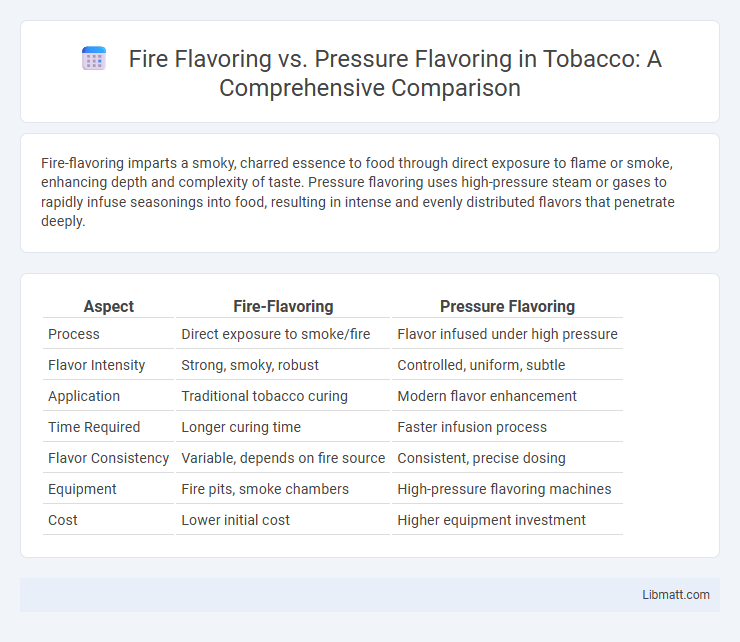Fire-flavoring imparts a smoky, charred essence to food through direct exposure to flame or smoke, enhancing depth and complexity of taste. Pressure flavoring uses high-pressure steam or gases to rapidly infuse seasonings into food, resulting in intense and evenly distributed flavors that penetrate deeply.
Table of Comparison
| Aspect | Fire-Flavoring | Pressure Flavoring |
|---|---|---|
| Process | Direct exposure to smoke/fire | Flavor infused under high pressure |
| Flavor Intensity | Strong, smoky, robust | Controlled, uniform, subtle |
| Application | Traditional tobacco curing | Modern flavor enhancement |
| Time Required | Longer curing time | Faster infusion process |
| Flavor Consistency | Variable, depends on fire source | Consistent, precise dosing |
| Equipment | Fire pits, smoke chambers | High-pressure flavoring machines |
| Cost | Lower initial cost | Higher equipment investment |
Introduction to Flavor-Infusing Techniques
Fire-flavoring utilizes direct smoke and charring to penetrate meats and vegetables with robust, smoky undertones, enhancing depth and complexity in your dishes. Pressure flavoring employs high pressure to force marinades and seasonings deep into the food, resulting in evenly infused flavors in a shorter time. Understanding both techniques allows you to optimize flavor intensity and texture according to your culinary goals.
What Is Fire-Flavoring?
Fire-flavoring involves exposing food directly to open flames or hot smoke, infusing it with a distinct smoky, charred aroma that enhances texture and depth of flavor. Unlike pressure flavoring, which uses high pressure to infuse marinades or brines rapidly into meat, fire-flavoring relies on combustion compounds such as phenols and guaiacol to impart rich, complex smoky notes. Commonly applied in barbecue and smoked meats, fire-flavoring creates a signature taste profile through controlled burning of hardwood or charcoal.
The Science Behind Fire-Infused Flavors
Fire-flavoring leverages the Maillard reaction and volatile combustion compounds to impart smoky, charred notes that enhance the complexity of food and beverages. Pressure flavoring accelerates the infusion process by forcing flavor molecules into the product under high pressure, intensifying taste profiles without altering texture significantly. Understanding these distinct chemical interactions highlights the unique sensory impacts achieved through fire-infused versus pressure-based flavoring techniques.
Understanding Pressure Flavoring
Pressure flavoring uses high pressure to infuse marinades and seasonings deeply into meat, enhancing taste and tenderness far more effectively than fire-flavoring, which primarily imparts surface flavor through smoke and charring. This technique accelerates flavor absorption, reducing marination time from hours to minutes while achieving a uniform, intense taste throughout the protein. Industrial kitchens and BBQ enthusiasts increasingly prefer pressure flavoring for its efficiency and consistent results in flavor penetration compared to traditional fire-flavoring methods.
How Pressure Cooking Alters Taste Profiles
Pressure cooking intensifies your food's flavor by trapping steam and increasing temperature, which accelerates Maillard reactions and caramelization, resulting in richer and deeper taste profiles compared to fire-flavoring. This method preserves moisture and infuses ingredients more thoroughly, enhancing umami and reducing bitterness. Unlike fire-flavoring, which imparts smoky or charred notes, pressure cooking delivers concentrated, well-rounded flavors that develop without the risk of burning.
Key Differences: Fire-Flavoring vs Pressure Flavoring
Fire-flavoring infuses ingredients with smoky, charred notes using open flame or wood smoke, enhancing aroma and taste through natural combustion compounds. Pressure flavoring accelerates marinade absorption by applying high pressure, forcing flavors deep into meat or vegetables in a shorter time without altering the food's original texture. Your choice depends on whether you prefer traditional smoky depth or rapid, intense flavor infusion.
Pros and Cons of Fire-Infused Methods
Fire-infused flavoring enhances food with rich, smoky undertones and complex aromas that traditional seasoning cannot match, offering a natural way to deepen taste profiles. However, it requires careful control to avoid bitterness or over-charring, which can overpower delicate ingredients. Compared to pressure flavoring, fire methods lack precision and consistency but excel in delivering unique, intensely flavorful results prized in culinary arts.
Advantages and Limitations of Pressure Flavoring
Pressure flavoring excels in rapid and uniform infusion of marinades or seasonings into foods like meats and vegetables, enhancing flavor depth without prolonged soaking. Its advantages include reduced processing time, consistent taste penetration, and retention of moisture and texture. Limitations involve higher equipment costs, potential texture alterations from excessive pressure, and the need for precise control to avoid over-flavoring or product damage.
Culinary Applications and Recipe Ideas
Fire-flavoring imparts a smoky, charred essence ideal for grilling meats, roasting vegetables, and enhancing barbecue dishes with rich, intense aromas. Pressure flavoring accelerates marination processes by infusing spices and herbs deeply into proteins, perfect for quick-cooking recipes like stews, braises, and infused stocks. Your culinary creations benefit from combining both techniques to achieve complex layers of flavor and tenderness in diverse recipes.
Choosing the Right Technique for Exceptional Flavor
Fire-flavoring infuses foods with smoky, charred notes by exposing them to direct flames or wood smoke, ideal for grilling meats and vegetables to enhance their natural taste. Pressure flavoring uses high pressure to rapidly infuse marinades or seasoning deep into the food, significantly reducing marination time while intensifying flavor absorption. Your choice depends on desired flavor profiles: fire-flavoring adds complexity and smokiness, while pressure flavoring delivers a more intense, uniformly seasoned result.
fire-flavoring vs pressure flavoring Infographic

 libmatt.com
libmatt.com